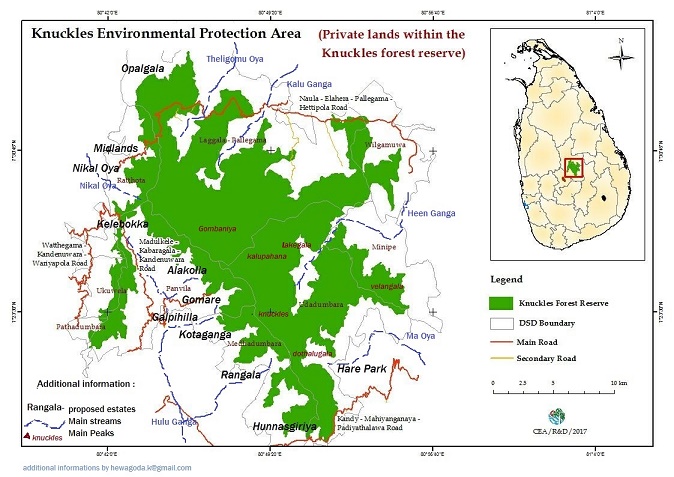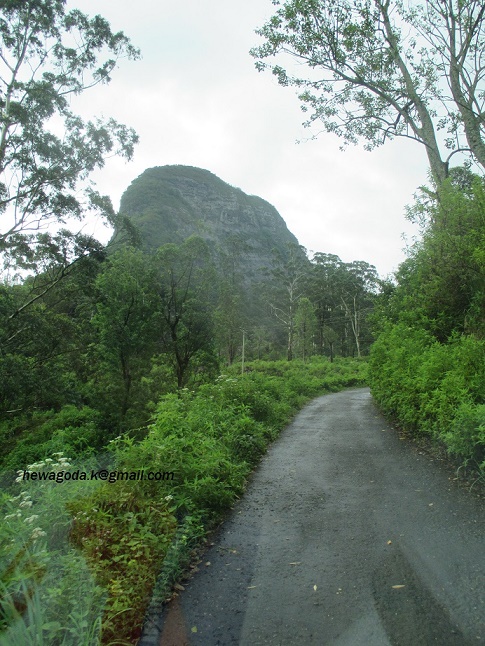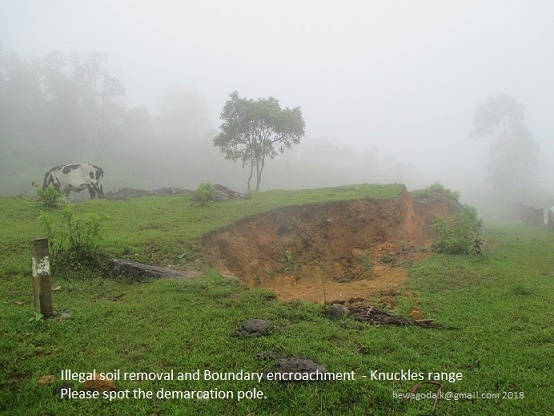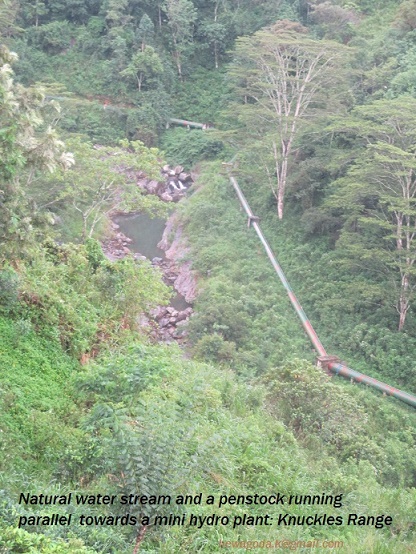An open complaint regarding the leasing out of large portions of Environmentally Protected Land in Knuckles (Dumbara ) range.
Posted on June 12th, 2018
Keerthi Hewagoda Environmental Activist
Introduction
The Knuckles range or traditionally called the Dumbara Adaviya is a massif located in central hills in Sri Lanka. The term range” encompasses not only the knuckles forest reserve but whole the ecological unit that geographically belongs to the Knuckles massif. The area above 1500 meters (approx. 4900 feet) in the Knuckles range was declared as a climatic reserve in 1873 and in 1988 the Knuckles Conservation Area was declared over all lands above 1,067 metres (Approx 3500 feet Amsl). The Knuckles conservation area was subjected to a floral and faunal survey under the National Conservation Review (1992-1996) (5). Considering the high biodiversity and significant cultural value, the Central Highlands, including Knuckles Conservation Forest was declared as a UNESCO World Heritage Property in 2010

Under the Soil Conservation Ordinance of 1993, human activity had been restricted in certain areas in the Knuckles. As for management plan, the Knuckles Range was surveyed, demarcated and declared as a Conservation Forest in 2000 under the Forest Ordinance Act 1907 (Gazette No. 1130). And, in July 2007, with the objective of regulating unauthorized activities on the private lands in the vicinity of the knuckles conservation forest, all private land within the boundary of KCF were declared as an environmental protected area (EPA) under National Environmental Act No. 47 of 1980. (5) Further this Act facilitates acquire of non-state lands and include them to the forest reserve.

The knuckles forest is a refugium for number of point endemics; Leaf nose lizard (Ceretophora Tennennti) Crestless Lizard (Calotes liocephalus) ,an endemic fish Laubuka insularis, and Kirthisinghe Rock frog (Nannophrys marmorata) are found only in knuckles range , and has been home to indigenous community since historic times, and represent their culture, traditions and spiritual beliefs, thus conserving an anthropological heritage.
Complaint
With cabinet directive 2017/81 dated 2017.11.23, the Sri Lankan government is going to lease the large tracts of land in Knuckles range to the private ownerships for long periods for,
1- Factory farms (Livestock)
2- Mineral excavation
3- Tourism
4- Bottled water industry
5- Mini / small hydropower plants
The state owned Estates those will be leased are the Opalgala , Nikal Oya, Midlands, Kele bokka, Alakola, Gomare, Galpihilla, Kota gala, Rangala , Hare park and some others comprising a total of approx.: 21000 acres. And the Government ministers Kabir Hasheem and Lakshman Kiriella and the government institutions; SLSPC are involved in this land issue. The critical observations could be summarized as follow;
Adverse Biological impacts
1- Animal farms could make a devastating impact to the surrounding environment. (2,3).
(A) Transmission of contagious animal disease to wild animals.(2)(7)
(B) Pollution of nature water ways by large amount of excreted nitrogenous substances. (8)
(C) Direct affect into food webs by consumption, predation and parasitism etc. This scenario will change the vectors in a sensitive eco system.(2)
(D) Random or voluntarily introduction of invasive plants (grass)
(C) Herds may wander into the reserve
(D) Pharmaceutical contaminants and residues from intensive animal breeding.
2- Contamination by Fertilizers and pesticides.
3- The hydropower plants have impact on the fish populations as their migration is effectively barred by dams and dry river beds (6)
4- Bio-piracy and smuggling. (9)

Adverse Geological and Ecological impact
1- Mineral excavation ( mining of quarts, blasting rocks with explosives gives rise to noise pollution, air pollution, damage to biodiversity and habitat destruction etc.)
2- Landslides and flood risk. (Removal of soil, Mining sites, roads and aggressive land usages).
3- Change of hydrological patterns. (Run off and level ground water etc.). The Impediment of natural flow of water causes the spillage or change in the direction of water current. As a result some areas will always be flooded during the rainy season.
4- Hydropower dams modify natural cycles of high and low flows, and restricts sediment movement

Adverse Economic and social impact
1– Diminish of water quality (waste from animal production, quarrying, fertilizer)
2- The shortage of drinking water and obstruction of natural water ways caused by the bottled water plants.
3- Deformed hydrological pattern will affect the local agriculture and compromise the Mahaweli head waters fed by the Hulu Ganga. The Knuckles is the main catchment area of Sri Lanka’s longest river Mahaweli.
4- Cultural impact on indigenous inhabitants through the uncontrolled tourism, industrialisation and commercialisation. (Hotels, Alcoholic beverages, eco mafias, unethical customs etc.)
5- Waste management and garbage disposal in area will create serious problems (Pollution of natural water ways, soil and public health. Even now, the random garbage disposals right into the Hulu Ganga valley can be seen)
6-Exploitation and manipulation of cultural heritage (treasure hunting, vandalism of archaeological sites, constructions aimed for religious or cult practices)
7-Above mentioned projects will irreparably damage the aesthetic beauty of knuckles range
Further there are underlying political implications those should be addressed with time. It must be noted that the Knuckles range is already threatened by the spreading of invasive plants, ground fires, boundary encroachments, tourism related activities and by illegal agricultural practices etc.; and the leasing out of these lands will dramatically increase the damage. We strongly urge the Sri Lankan Government to stop handing these eco sensitive lands to environmentally destructive activities.
(Please check the files and sources attached herewith.)
Signed:- dated 10.06.2018
Environmental Activist
Keerthi Hewagoda
Tel : +94 0765561912
Email- hewagoda.k@gmail.com
The copies attached herewith
1- Map of the Knuckles reserve and the proposed estates for lease. (4)
2- Photo evidences of government papers related to this unethical land deal.
3- Photos of some of the locations/ implications mentioned in this paper taken by author after ground exploration in Knuckles range
Endnotes and Sources –
1- Any singular group or complex network of people committing ‘Organized crimes’ that cause damage to the environment; or engaged in any lucrative activity related with the environment, represents what is currently known as Eco-Mafia.
2- http://www.fao.org/3/a-i4891e.pdf
3- Infectious animal diseases: the wildlife/ livestock interface. By R.G.Bengis, R.A.Kock & J.Fischer . 2002
4- Knuckles environmental protection area by CEA.
5- Management framework for the world heritage serial property central highlands of Sri Lanka.- IUCN, UK aid, Government of Sri Lanka- published in December 2011
6- Notes of Chandra Bhushan (CSE Delhi) regarding the impact of small hydropower plants
7- Careless dumping of livestock waste on farm lands and direct discharge to waterways and percolation to groundwater usually bypass via cracks and fissures is a great risk to human and animal health because livestock waste contains myriads of pathogens (Davies, 1997; Dizer et al 1984), some of which may be zoonotic and can cause systematic or local infections. (Dizer et al 1984 , Mackenzie et al 1998, Davies 1997,Cameron et al 1998, Fischer et al 2000, Stanley et al 1998). Highly contagious and pathogenic disease, such as foot and mouth disease and swine fever may spread with animal exertions through waterways (Cameron et al 2000)
8- Livestock waste produces ammonia that can be a potential pollutant causing serious eutrophication of rivers and lakes characterized by a high concentration of nutrients that creates an ecological imbalance in the water system that supports abnormally high levels of algae and aquatic plant growths.( Burton and Turner 2003: IAEA/ FAO 2008).This reduces oxygen levels in the waters and has serious implications on the survival of aquatic organisms and consequently on food supply and biodiversity (IAEA/ FAO 2008)
9- Companies that bio prospect do not, however, always respect the interests and values of the indigenous peoples from whom they gather ethnobotanical information and resources.”- Bioprospecting and Biopiracy in Latin America: The Case of Maca in Perú .Amanda J. Landon. 2007
10- The cultural features of KCF relevant to its inclusion as a constituent of the property being nominated as a Mixed Heritage relates mainly to the evidence of cave dwelling humans dating back to the Mesolithic period- Nomination of the Central Highlands of Sri Lanka: Its Cultural and Natural Heritage. Submitted to Unesco 1 January 2008 by SL Government.
This compliant has been sent to :- Hon. President of Sri Lanka, Hon.Prime minister, politicians of the opposition, Buddha Sasana Amathyanshaya, Archaeological department, Mahaweli authority, Forest department, Wild life department, Central Environment authority, Sri Lanka state plantation corporation, Land Reform Commision, Ministry of Health, Sri lanka Mining bureau, NARA, Department of Geology, University of Peradeniya, National commission for Unesco, UN, UNESCO, FAO, WWF, CAO, IUCN,UKAID, WHO, Environmental Law Centre and national and international mass media , Environmentalists, researchers and to academics and openly shared with common public . The author bears the responsibility of paper with belief of rationalism, knowledge and truthfulness.